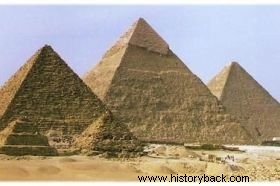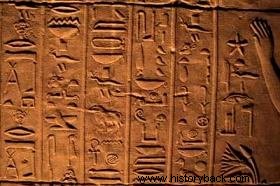Egyptian Civilization was one of the most important civilizations that developed in the region of the Fertile Crescent .
Located in the extreme northeast of Africa, in a region characterized by the existence of deserts and the vast plain of the Nile River.
The Egyptian Civilization was formed from the mixture of different peoples, among them, the Hamitic, the Semites and the Nubians, who appeared in the Paleolithic Period.
The first population centers only began to form during the Neolithic Period, when communities began to dedicate themselves more to agriculture than hunting or fishing.
Around 4000 BC, the ancient nuclei gave way to small political units, the nomos, ruled by nomarchs, which merged into two kingdoms, one from Lower Egypt , north and another from Upper Egypt , to the south.
Around 3200 BC, Menes , the ruler of Upper Nile, unified the two kingdoms and became the first pharaoh , giving rise to the dynastic period, which can be divided into three distinct moments:Old Kingdom, Middle Kingdom and New Kingdom.
Old Empire (3200 – 2300 BC) – time when the unification of Egypt was completed. The Egyptian capital became Tinis and later transferred to Memphis, in the Cairo Region (current capital of Egypt).
The pharaoh, considered a deity, ruled with absolute power. Between 2700 and 2600 BC, the pyramids of Giza were built, attributed to the pharaohs Cheops, Khafre and Menkaure .

Middle Empire (2000 – 1580 BC) - at this stage the pharaohs regained power that had been weakened by the action of the nomarchs. In conquered Palestine, a copper mine was found, and in Nubia, a gold mine.
Between 1800 and 1700 BC), the Hebrews retreating from Palestine, arrived in Egypt. The Hyksos , nomadic people of Asian origin, invade the country, remaining in the region until 1580 BC)
New Empire (1580 – 525 BC) – was marked by the expulsion of the Hyksos, the great military development and the conquest of a vast territory. The Hebrews were enslaved and around 1250 BC, under the leadership of Moses , the Hebrews managed to escape from Egypt, in the episode that became known as Exodus and is recorded in the Old Testament of the Bible.
The height of Egyptian civilization was reached during the long rule of pharaohRamses II (1292 – 1225 BC), who defeated several Asian peoples.
After his reign, the fights between the priests and the pharaohs weakened the state, which stimulated new invasions. In 525 BC, the Persians, commanded by Cambyres, defeated the Egyptians in the Battle of Pelusa and definitively conquered the region.
From then on, Egypt would not be independent for at least 2500 years, during which time it would successively become a province of the Persians, territory occupied by Macedonians, Romans, Arabs, Turks and finally English.
The constant invasions exerted a great influence on Egyptian culture, especially the Macedonian rule that allowed the penetration of Greek ideas.
This dominion established a dynasty of Macedonian origin, called Ptolemaic or Lagid, to which Cleopatra belonged.
Her son by the Roman Emperor Julius Caesar was the last Ptolemaic king. Then the region fell under Roman and later Arab rule. In this period, Christian and Muslim cultural elements were successively introduced.
Religion in Egyptian Civilization
Egyptian society was marked by a deep religiosity. Polytheists , worshiped several gods:Amon-Ra, protector of the pharaohs; Ptah, protector of artisans; Thoth, god of science and protector of scribes; Ambis, protector of embalming; Maat, goddess of justice, among others.
They believed in life after death and the return of the soul to the body, worshiped the dead and developed mummification techniques to preserve bodies.
Science in Egyptian Civilization
The Egyptians developed the study of mathematics and the geometry , mainly focused on civil construction . They used square root and fractions; they also calculated the area of the circle and the trapezoid.
Concern about the floods and ebbs of the Nile stimulated the development of astronomy . Observing the stars, they located planets and constellations.
The day was divided into 24 hours. The week had ten days and the month had three weeks. The 365-day year was divided into agrarian seasons:full, winter and summer.
The development of the practice of mummification allowed greater knowledge of human anatomy , making it possible to perform surgery on the skull. They treated diseases of the stomach, heart and fractures.
Writing developed in three ways:

- Hieroglyphic – the sacred writing of tombs and temples; the oldest, before 3000 BC, consisting of more than 600 characters.
- Hieratic – a simplification of hieroglyphics. Its use was linked to religion and power;
- Demotics – was the popular script, made up of about 350 signs, used in contracts drawn up by scribes.
You also may if interest by:
- Ancient Egypt
- Egyptian Art
- Egyptian Mythology
